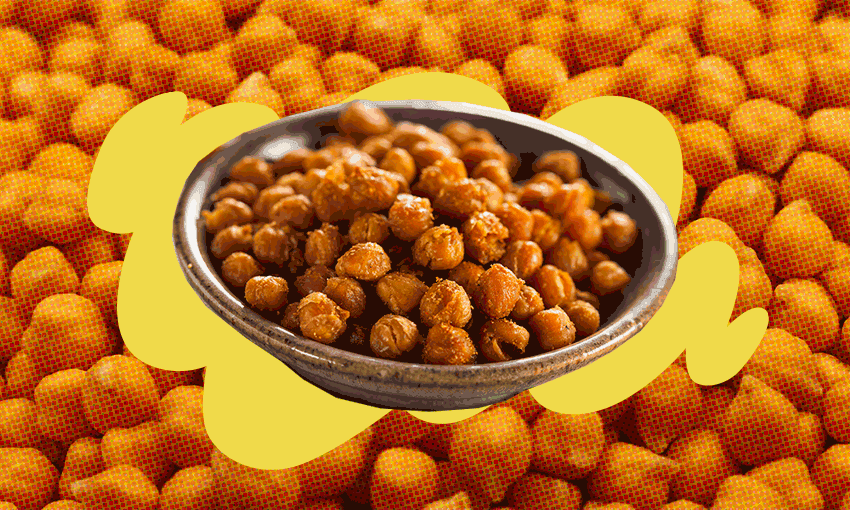Sometimes they live in the shadows at the back of the pantry, but when times get tough there’s a lot to praise and enjoy about a crafty can of chickpeas.
In a week flavoured by cyclone-induced cabin fever and zero trips to the supermarket, many of my meals were created in the spirit of “Hmm, what’s that at the back of the cupboard?”
The chickpea is a true hero in this situation. Amazingly versatile, filling, high in protein, and easy to cook with, I’m certainly a chickpea fan.
But let’s back up a little. Like so many foods typically only encountered in a can or plastic packet, it can be hard to imagine where chickpeas come from – or even to remember that they come from somewhere at all. So, here’s some wild chickpea imagery to fill your mind.
Chickpeas grow in short fat pods on bushy plants, like stubby little edamame beans. There’s one or two chickpeas in each pod, and like beans, you can eat chickpeas as a raw snack when the pods are green and immature. Dried chickpeas are harvested when the plant’s leaves have withered and dried, which answers the question, “which is natural, the plump chickpea or the dried chickpea?” The answer is “Both.”
Unexpected strange fact: in Europe during the 18th and 19th centuries, roasted chickpeas were sometimes brewed as a substitute for coffee. I won’t be chucking dried chickpeas in the coffee grinder anytime soon, but I’m certainly intrigued by the idea of a double shot chickpea latte, maybe alongside a small tahini cookie.
Where to find it
You can buy chickpeas as shrivelled little walnut-looking things in a packet, or as plump juicy morsels in a can. If you’re making falafel (or your own gram flour), you’ll want dried chickpeas. Most other meals use cooked chickpeas, which means buying them already tender in a can, or buying them dried and then bringing them back to toothsome life yourself. This involves a pressure cooker, or overnight soaking with a pinch of baking soda followed by about an hour of simmering.
On to the price. A can of chickpeas usually costs around the $2 mark. It’s pretty brand dependent, but the lowest price I could find was $1.29 from New World, and the most expensive was $2.60 from Countdown. None of the main three supermarkets, or Supie, seemed to have dried chickpeas available – I get mine from bulk stores, Asian supermarkets, or zero-plastic stores like GoodFor.
Dried chickpeas can be a hassle if the end product you need is plump, but they’re always significantly cheaper than canned. For example, $2 will get you 2 cups of organic dried chickpeas from GoodFor, which transforms into around 5 cups of cooked chickpeas – more than 3 cans worth. A bargain for those with a little time and patience up their sleeve.
How to make it terrible
The fact that the chickpea is a bit of a blank slate makes it hugely versatile, but it also makes it inherently dull if not treated with a little creativity (or at least smoked paprika and salt). If you’re after a flavour sensation, don’t just add a drained can of chickpeas to a green salad. This is only appropriate if all you’re looking for is a protein boost, and if that’s the case: please at least whip together a zesty vinaigrette.
Luckily, it’s incredibly easy to take chickpeas in plenty of delicious directions.
How to make it amazing
One of the earliest legumes to be cultivated, chickpeas are key to Mediterranean, Middle Eastern and Indian cuisine. Chickpeas make possible fan favourites like hummus, falafel, chana masala and crispy chickpeas.
The chickpea is also a friend to health-conscious dessert lovers. You can use chickpeas as the base for healthy, GF chocolate chip cookies (in place of flour and eggs), and the liquid found in canned chickpeas, aquafaba, is also a good vegan substitute for egg whites in meringue and ice cream.
This week my “what’s in the cupboard” cooking mentality led to the creation of a no-cook dinner of creamy smashed chickpeas (in a tangy Greek yoghurt and tahini-based dressing) and salad wraps, as well as a big container of hummus that I’m now devouring with corn chips and carrot sticks.
Homemade hummus is so easy, and the absolute best kind of dip – just blitz a can of chickpeas with about 1 Tbsp of tahini, 2 Tbsp of olive oil, and the juice of a lemon, plus salt, pepper, smoked paprika, and ground cumin to taste. Add water until you’ve got hummus that’s as thick or loose as ya like it, and your dip is done.
At the end of the day, though, crispy roasted chickpeas are my favourite use of the legume. Simply toss drained chickpeas in a little oil, salt, and your favourite spices, then roast on an oven tray for 10 minutes or until golden and crunchy on the outside, squishy and warm in the middle. They make a wholesome and moreish snack, or you can mix them through a salad like my halloumi and crispy chickpea salad with herby dressing.
Wyoming Paul is the co-founder of Grossr, and runs a weekly meal plan that connects to online supermarket shopping.

